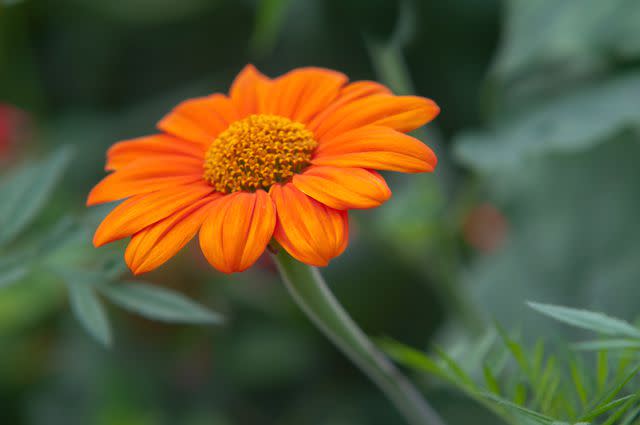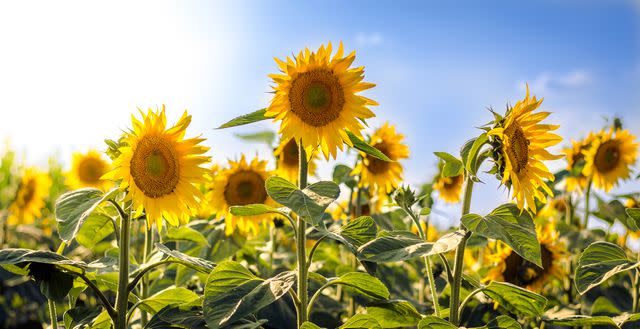How to Grow and Care for Mexican Sunflowers
:max_bytes(150000):strip_icc():format(jpeg)/mexican-sunflower-plant-profile-4687502_03-fc0229e2ffff43e88bf2f53feb80c124.jpg)
The Spruce / Evgeniya Vlasova
Reviewed by Barbara Gillette
Mexican sunflowers yield dozens of showy daisy-like blooms in fiery shades of red, orange, or yellow from summer into fall. These show-stopping annuals can be planted after the last frost and thrive in well-draining soil, as long as they are offered full sun, or six or more hours of unfiltered sunlight per day.
Common Name | Mexican Sunflower, tree marigold |
Botanical Name | Tithonia rotundifolia |
Family | Asteraceae |
Plant Type | Annual, perennial |
Mature Size | 3-6 ft. tall, 2-3 ft. wide |
Sun Exposure | Full |
Soil Type | Well-drained |
Soil pH | Neutral to acidic |
Bloom Time | Summer, fall |
Flower Color | Orange, red, yellow |
Hardiness Zones | 9-11 (USDA) |
Native Area | Central America |
Mexican Sunflower Care
Mexican sunflowers are ideal for the beginner gardener who wants pops of color to fill in a large blank spot in the flower border. Here are the main care requirements for Mexican sunflowers:
Choose a sunny spot that gets at least six hours of direct sunlight per day.
Prepare well-draining soil.
Water occasionally, though these plants are drought-tolerant.
Consider, fertilizing initially; repeat fertilization is not needed throughout the growing season.

The Spruce / Evgeniya Vlasova

The Spruce / Evgeniya Vlasova

The Spruce / Evgeniya Vlasova
Light
Full sun is a critical factor in growing healthy Mexican sunflowers. Plants growing in shady areas may not bloom, will flop over, and might suffer from fungal diseases.
Soil
Save your soil amendments for fussier flowers like roses and dahlias, because Mexican sunflowers like lean soils with low nutrient content. Good drainage is important to prevent problems like root rot. Sandy or rocky soils more closely resemble the native soils of Mexico where the plants grow wild.
Water
Mexican sunflowers are drought tolerant throughout their life cycle and don't need watering, contributing to their low-maintenance charm. Wet soil is not tolerated by Mexican sunflowers, but if your area gets more rain than average, you can compensate for this by planting them in soil with excellent drainage.
Temperature and Humidity
Mexican sunflowers love hot weather, even days with triple-digit temperatures. Conversely, cool weather stops the Mexican sunflower in its tracks. When nighttime temperatures are in the 60s, it’s the right time to grow Mexican sunflowers. Average humidity is best for healthy plants. Provide extra spacing for plants in humid areas to prevent powdery mildew.
Fertilizer
Mexican sunflowers grow just fine without any supplemental fertilizer. In areas with especially depleted soils, you can add an all-purpose flower fertilizer at the beginning of the season to get plants off to a quick start. For the amount, follow the product label instructions.
Types of Mexican Sunflowers
T. rotundifolia ‘Fiesta del Sol’ is a dwarf variety for smaller gardens or containers, growing between 2 and 3 feet in height.
T. rotundifolia ‘Goldfinger’ is another good dwarf variety.
T. rotundifolia ‘Torch’ is the mainstay of Mexican sunflowers, growing in gardens since the 1950s.
T. rotundifolia 'Yellow Torch' offers yellow blooms with a slight orange hue.

Sasa Pokimica/Getty Images
Common SunflowersPruning
Pruning Mexican sunflowers isn’t necessary but can help to get lanky plants under control or to keep overgrown plants in bounds. Keep in mind that you may sacrifice some blooms when pruning. Cut off the top 1/3 of the plant when it’s experiencing a lull in blooming to both deadhead and tidy the plant.
Propagating Mexican Sunflowers
Although the Mexican sunflower is easy to grow from seed, if you can’t find your favorite variety you can also propagate plants by stem cuttings. Unlike established Mexican sunflowers, this type of propagation requires daily watering to get the cuttings to root. Here's how it's done:
Take two or three stem pieces and cut them down with sharp pruners to about 12 inches tall.
Remove all but one pair of leaves on the stem. Cut the remaining leaves in half, as they are too large to be supported by the cutting.
For each cutting, fill a 4-inch pot (plastic, clay, or terra cotta) with large drain holes with loose potting medium. Water until the soil is moist.
Insert about 6 inches of the stem into the soil and gently press down the soil around the stem.
Keep the pots in a location with filtered sun and water daily. Expect roots to form in about 10 days.
Transplant outdoors in about eight weeks, or when they have developed a strong root system and the roots start to grow out of the pot's drain holes.
How to Grow Mexican Sunflowers From Seed
Mexican sunflowers are easy to grow from seed. You can start the seeds indoors or wait until the last frost has passed.
Choose a sunny spot with well-draining soil.
Directly sow the seeds into the soil about an inch deep.
Once the seedlings have begun to germinate, thin them so that there is about two feet between each plant.
If growing in containers, thin to just one or two plants per pot.
Potting and Repotting Mexican Sunflowers
You can also grow dwarf varieties of Mexican sunflowers in pots on your patio, deck, or balcony. Like for all patio plants, breathable clay or terra cotta pots with large drain holes are the best choice because they keep the soil cooler than plastic pots and ensure evaporation.
Because Mexican sunflowers are annuals in most zones, choose a pot that will fit the mature plant without requiring any repotting during their single-season lifespan. A gallon-pot is a good size for one sunflower. Plant it in the center of the pot. Mexican sunflowers are also attractive in larger planters with trailing plants like million bells or portulaca, which also appreciate full sun and dry conditions.
Common Pests and Plant Diseases
Snails and slugs sometimes bother Mexican sunflowers, especially in rainy weather. Place a piece of damp cardboard beside plants and collect the pests when they hide during daylight hours. The plants might suffer from fungal diseases if the area is too shady, and they might suffer from powdery mildew if they are too crowded, especially in humid areas.
How to Get Mexican Sunflowers to Bloom
Unlike other plants, Mexican sunflowers thrive in rocky or sandy soil. In fact, you might get better blooms from poor soil than you will from robust, nutrient-rich soil. Sun is also a factor, as these plants need a lot of it. If they still aren't blooming, consider that they might have too much water sitting around the roots; the soil must be well-draining.
Bloom Months
Mexican sunflowers bloom in mid-summer, usually around July, and continue to bloom through fall until the first frost.
What Do Mexican Sunflowers Look and Smell Like?
Mexican sunflower flowers look like large daisies with orange-red petals and a yellow center. Each plant produces many flowers, which attract tons of pollinators, including butterflies. They are not particularly fragrant but do have a light, sweet scent.
How to Encourage More Blooms
It's critical that Mexican sunflowers receive full sunlight. Otherwise, they will not grow as tall and offer as many blooms. If growing in a spot that gets at least six hours of sun, these plants should bloom readily.
Caring for Mexican Sunflowers After They Bloom
As annuals, there is nothing special that you should do after Mexican sunflowers bloom, as they will simply die in winter. You may want to collect the developed flowers for their seeds.
Deadheading Mexican Sunflowers
Deadheading spent Mexican sunflowers can prolong blooming, but it's not needed. These low-maintenance plants will offer plentiful flowers through fall whether you deadhead them or not.
Frequently Asked Questions
What is the difference between sunflowers and Mexican sunflowers?
Mexican sunflowers and common sunflowers (Helianthus annuus) are both tall, sun-loving annual flowers that tolerate dry and poor soils. Common sunflowers usually have larger blooms, sometimes larger than 12 inches in diameter, and many varieties also have edible seeds. Grow the two sunflower plants at the back of the border for a visual and pollinator feast.
What do I do with Mexican sunflowers at the end of the season?
These flowers provide excellent nutrients to the garden. Cut them down, chop up the stalks, and add them to your compost bin.
Can Mexican sunflowers grow indoors?
Though you might try dwarf varieties as container plants, these need to be kept outside so they get the proper sunlight and high temperatures they need to thrive.
Read the original article on The Spruce.

